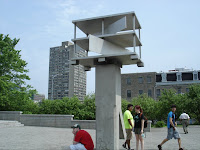Our visit to the Canadian Centre of Architecture was facilitated because of the background information given to the students prior to our trip. In particular, we discussed Phyllis Lambert’s role in founding the CCA, along with her significant role in helping preserve Montreal architectural (and by extension, cultural) heritage.
We began our visit by exploring the CCA garden, which helped to restore the urban fabric of an area deeply scarred by mid-20th-century highway engineering. Lying at the edge of an escarpment, it faces the CCA building from the south side of boulevard René-Lévesque. The garden was designed by Montréal artist-architect Melvin Charney as part of the Québec government’s competition program for the integration of art and architecture, combining sculpture and public space on a site granted to the CCA by the City of Montréal in 1986. At once a garden in the city and a museum in the open air, it evokes the history of landscape design and comments on Montréal’s early industrial sector below the hill, initiating a dialogue between nature, architecture, and the urban fabric. The garden is laid out as a series of narrative episodes – Orchard, Meadow, Arcade (mirror of the Shaughnessy House), Esplanade, Belvedere, and Allegorical Columns. Collectively they speak of the history of architecture and the history of the city.

We then toured the CCA building, designed in 1989 by Peter Rose, which is integrated with the historically classified Shaughnessy House from 1874. The Shaughnessy House is one of the rare 19th-century Montréal houses open to the public. Through scale, siting, and the juxtaposition of traditional and modern materials such as Montréal grey limestone and structural aluminum, the CCA building relates architecture past and present.
The temporary exhibition at the CCA, entitled Architecture in Uniform: Designing and Building for the Second World War, documents the extensive contribution of architecture to the war between the bombings of Guernica in 1937 and Hiroshima in 1945, and considers how this questioned architectural methods and construction technologies, and lead to the supremacy of modernism.
Overall, this trip was a great ‘hands-on’ learning experience on Canadian architecture!